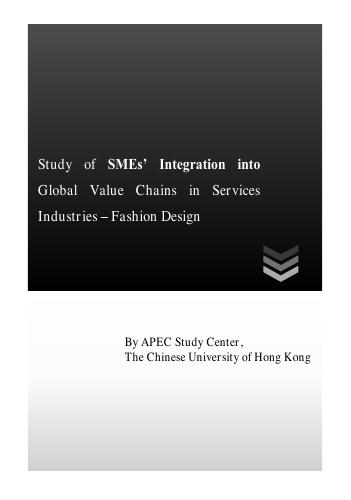Abstract
Integrating into global value chains (GVCs) provides business opportunities for small and medium enterprises (SMEs) in the fashion industry. At the economic level, SMEs’ integration into GVCs has many benefits to society, including boosting exports, creating job opportunities, encouraging creativity and promoting further economic development. Governments may be in a position to provide policies to facilitate the integration process. Thus, from the viewpoints of fashion SMEs and governments, it is important to better understand how the industry interacts with GVC business models to achieve desirable outcomes and how governments can effectively support SMEs’ integration into GVCs.
This study analyses GVCs in the fashion industry. Six value-adding activities are identified: research and new product development; design; production; logistics and distribution; marketing and branding; and services. They belong to higher value-adding activities located either upstream or downstream of the GVC. Manufacturing and assembly are considered lower value-adding activities. The economic upgrading process requires a move from low to high value-adding activities.
According to some successful case studies of the industry and a literature review, participation in GVCs is a major channel for fashion SMEs in the economic upgrading process. For example, an SME can participate in a GVC as an original equipment manufacturer (OEM) that receives orders from other firms and takes responsibility for all production activities, including cut, make and trim (CMT) activities and finishing and distribution. After gaining expertise and a better understanding of overseas markets, the firm can develop and upgrade to the original brand management (OBM) stage in which it can produce and market under its own brand name. Other benefits of fashion SMEs’ participation in GVCs include market expansion, acquisition of updated knowledge and innovation encouragement.
The e-commerce boom has facilitated fashion SMEs’ integration into GVCs. The B2B model makes communication within the supply chain more convenient, while the B2C model makes SMEs easier to access overseas. Recent trends in production fragmentation also provide ample opportunities for fashion SMEs to participate in GVCs and experience core competitiveness. Although fashion SMEs’ integration into GVCs has many benefits, there are also many challenges involved, especially in terms of competition with large enterprises. Without economies of scale, SMEs may be at a disadvantage in knowledge and skills development, business model innovation and creativity, information and communications technology (ICT) and sustainability and environmental concerns. This study provides policy recommendations for governments to support fashion SMEs’ participation in GVCs in design, manufacturing, marketing and branding, financing and other areas.

